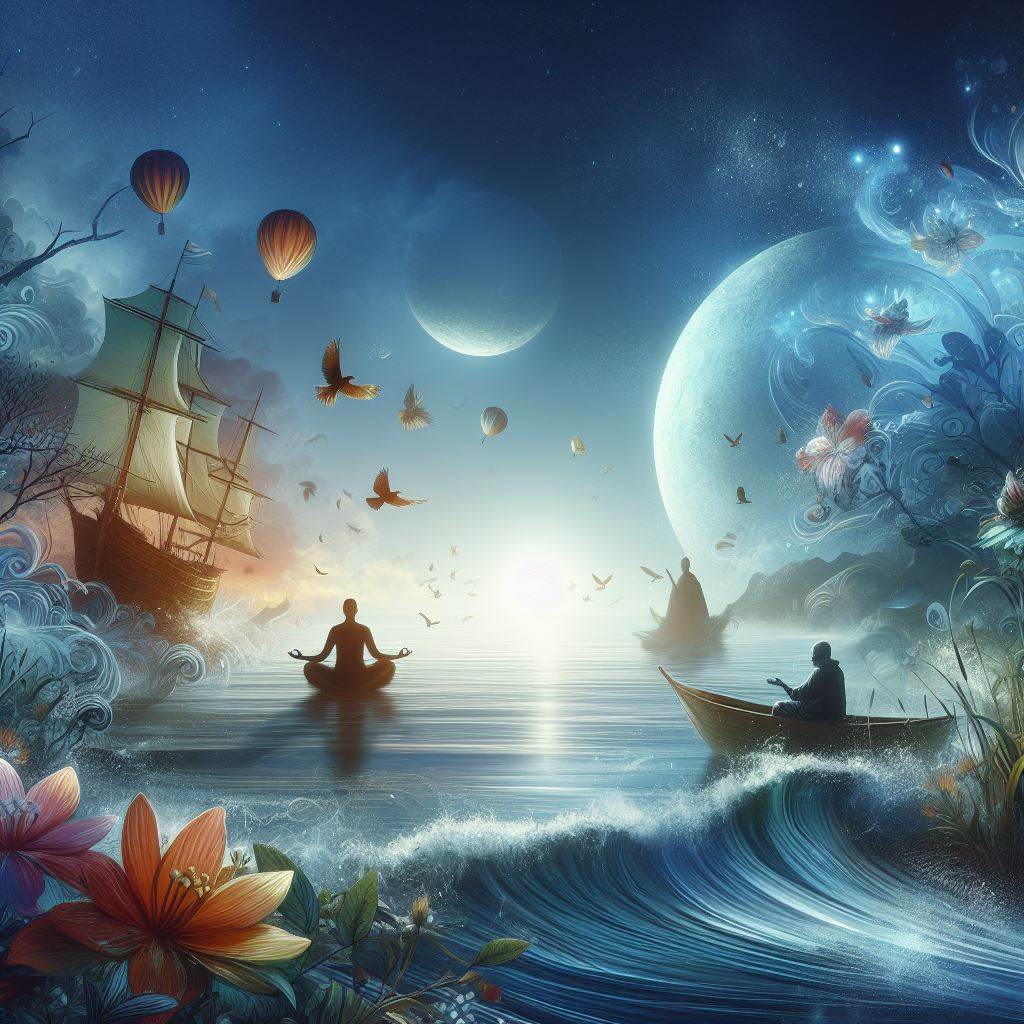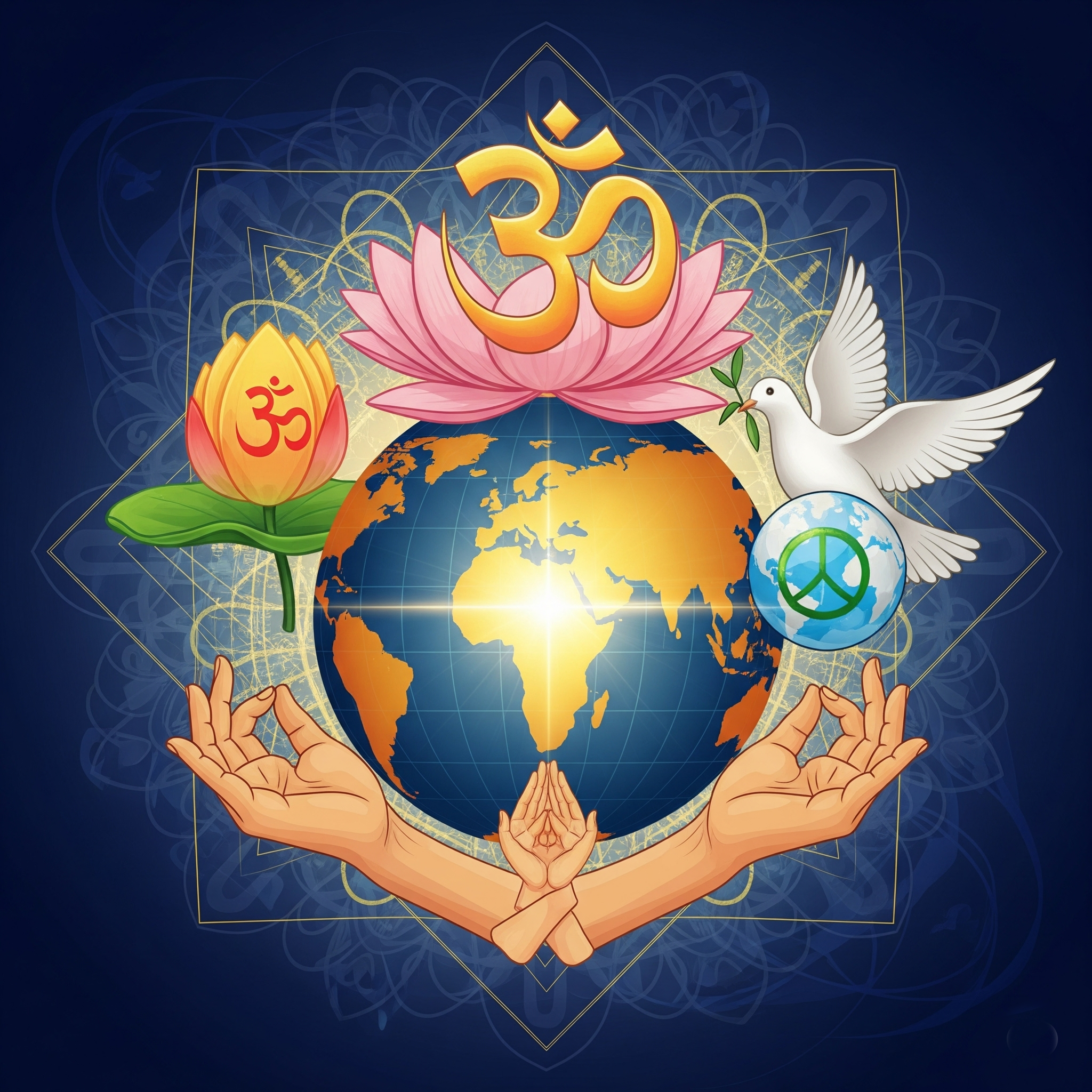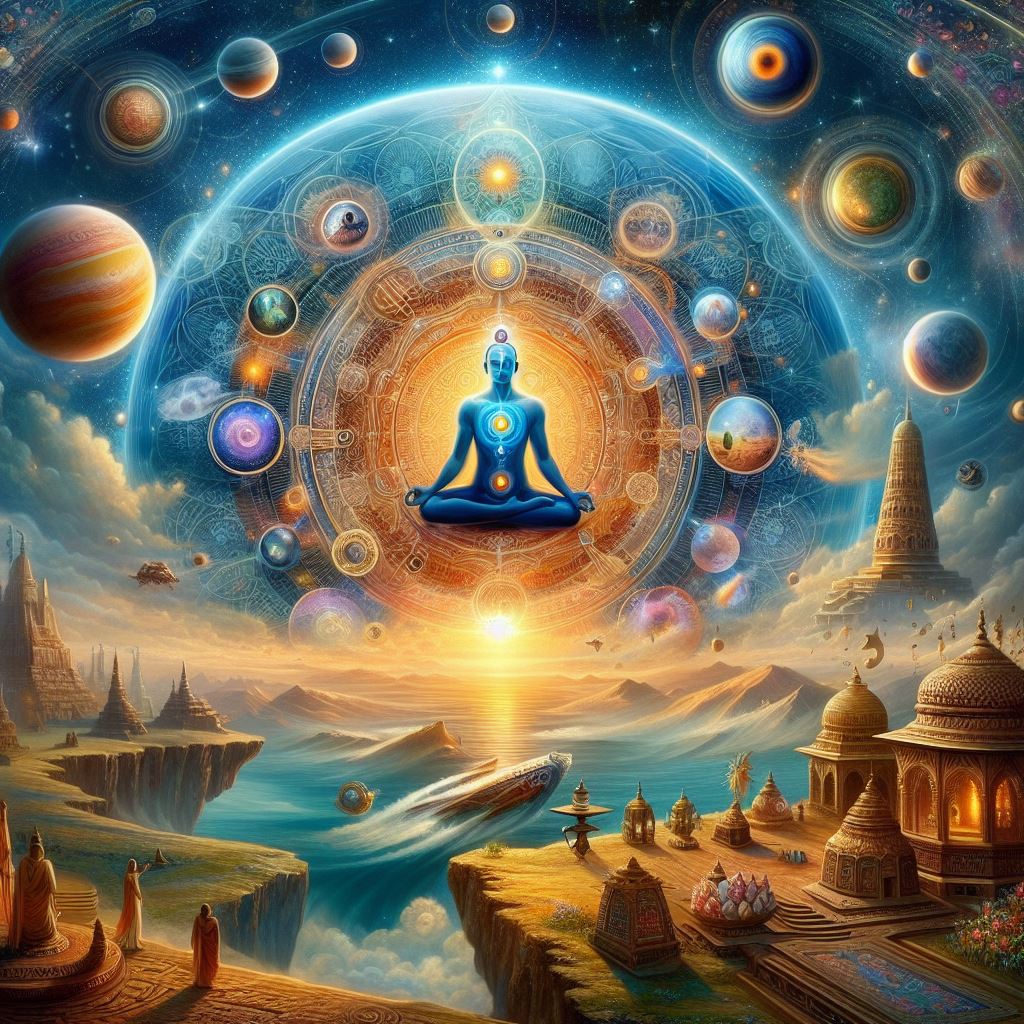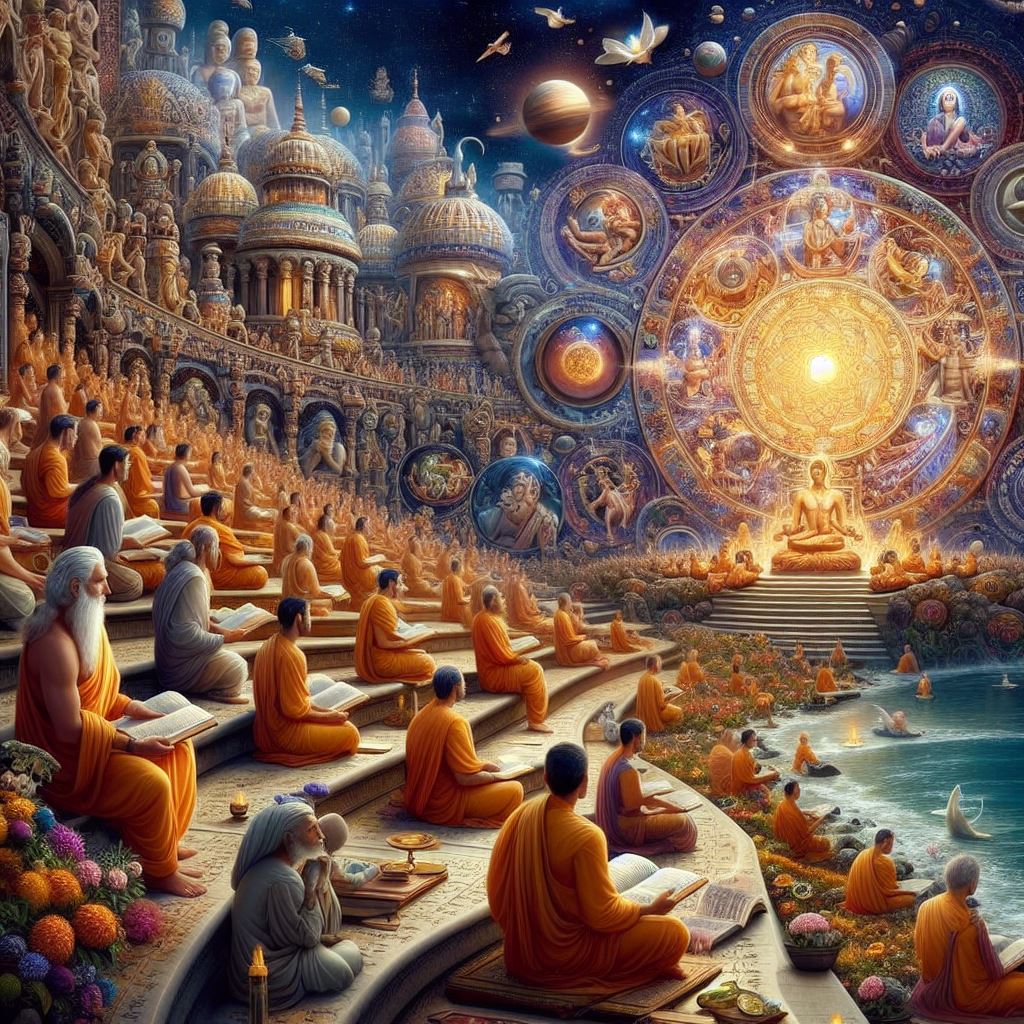Introduction
The investigation of the intricate relationship between the material world and consciousness has been a central and enduring theme in both scientific and philosophical discourse throughout history. This article takes a deep dive into the amalgamation of recent scientific discoveries and ancient Vedic philosophy, with a focus on the profound insights offered by Adi Shankaracharya’s teachings. By intertwining these perspectives, the article aims to provide a thorough and nuanced understanding of the nature of reality.
Scientific Perspective
In modern science, matter is fundamentally understood as the physical substance that constitutes the observable universe. This includes all tangible entities, from subatomic particles to galaxies, all of which adhere to the rigorous laws of physics. Matter is inherently measurable, allowing scientists to observe, quantify, and analyze its various forms and interactions. Classical physics, encompassing Newtonian mechanics, electromagnetism, and thermodynamics, has provided robust frameworks for understanding the behaviour of matter at macroscopic scales.
On the other hand, consciousness has traditionally been regarded as a phenomenon that eludes straightforward scientific measurement and quantification. Defined broadly as being aware of and able to think, consciousness encompasses subjective experiences, thoughts, and emotions. Consciousness was primarily the domain of philosophy and psychology for a long time, given its intangible nature. The challenge of explaining how physical processes in the brain give rise to conscious experience is often referred to as the “hard problem” of consciousness, a term coined by philosopher David Chalmers.
Recent advancements in quantum physics, are beginning to challenge the clear-cut dichotomy between matter and consciousness. Quantum mechanics, the branch of physics that deals with the behaviour of particles at atomic and subatomic levels, has introduced concepts that suggest a more intricate connection between the observer (consciousness) and the observed (matter).
Quantum Mechanics and Consciousness
One of the most striking revelations of quantum mechanics is the principle of superposition, which posits that particles can exist in multiple states simultaneously. This phenomenon is famously illustrated by the double-slit experiment, where particles such as electrons display both wave-like and particle-like properties. When not observed, they appear to traverse multiple paths simultaneously, creating an interference pattern. However, when an observation is made, the particles collapse into a single state, behaving like distinct particles.
This experiment implies that the act of observation—essentially the presence of consciousness—affects the physical state of particles. The Copenhagen interpretation, formulated by Niels Bohr and Werner Heisenberg, suggests that quantum systems do not have definite properties until they are measured. Until that point, they exist in a superposition of all possible states. This introduces the idea that consciousness might play a role in determining physical reality, a concept that diverges significantly from classical physics’ deterministic worldview.
Furthering this notion, physicist Eugene Wigner proposed that consciousness is necessary for the collapse of the wave function, a fundamental process in quantum mechanics. According to Wigner, the wave function, which describes the probabilities of a quantum system’s states, collapses into a definite state upon observation by a conscious being. This implies that consciousness has a direct impact on the physical world, blurring the line between the observer and the observed.
Neuroscience and Consciousness
In parallel with quantum physics, advancements in neuroscience have provided deeper insights into the nature of consciousness. Neuroscientists study how brain activity correlates with subjective experiences, aiming to uncover the mechanisms underlying conscious thought. Integrated Information Theory (IIT), proposed by neuroscientist Giulio Tononi, suggests that consciousness arises from the integration of information within the brain. According to IIT, the more integrated and differentiated the information processed by a system, the higher its level of consciousness.
Another prominent theory is the Global Workspace Theory (GWT), developed by Bernard Baars. GWT posits that consciousness involves a global workspace in the brain where information is broadcast to various cognitive systems, facilitating widespread access and integration. This theory likens the brain to a theatre, where conscious experiences are akin to actors on a stage, illuminated by the spotlight of attention.
Despite these advancements, the hard problem of consciousness remains unresolved. Neuroscientific theories explain the neural correlates of consciousness but do not fully account for the subjective, qualitative aspects of conscious experience—what it feels like to be aware. This ongoing challenge highlights the complexity of bridging the gap between the physical processes of the brain and the intangible nature of consciousness.
The scientific perspective on matter and consciousness is evolving, driven by breakthroughs in quantum physics and neuroscience. While matter remains the measurable, observable substance of the universe, consciousness is increasingly seen as an integral component of physical reality. The interplay between the two suggests a more complex relationship than previously understood, challenging traditional views and opening new avenues for interdisciplinary research. As science continues to explore these frontiers, our understanding of reality may be profoundly transformed, integrating the tangible and the intangible into a unified framework.
Vedic Insights
Ancient Vedic philosophy, particularly as interpreted by the renowned sage Adi Shankaracharya, offers profound insights into the unification of matter and consciousness. Shankaracharya’s teachings in Advaita Vedanta provide a non-dualistic perspective that emphasizes the intrinsic interconnectedness of all existence. This philosophical approach challenges the apparent dichotomy between the physical and the spiritual, suggesting that they are fundamentally one and the same.
Advaita (Non-Duality)
Advaita Vedanta, one of the central philosophies of Hinduism, teaches that the perceived separation between matter and consciousness is an illusion, known as Maya. According to this philosophy, all existence is a manifestation of a single underlying reality called Brahman. Brahman is the ultimate, unchanging reality, amidst and beyond the world, which cannot be exactly defined. The distinctions we perceive in the material world—such as those between different objects, people, and experiences—are products of limited human perception and do not reflect the true nature of reality.
In his seminal work, Vivek Chudamani, Shankaracharya elaborates on this concept through various metaphors that illustrate the unity of existence. One such verse states:
अइक्यं तयोर्लक्षितयोर्न वाच्ययोः। निगद्यतेऽन्योन्यविरुद्धधर्मिणोः। खद्योतभान्वोरिव राजभृत्ययोः। पाम्बुराश्योः परमाणुमेर्वोः॥ 242॥ aइkyaṃ tayorlakṣitayorna vācyayoḥ, igadyateʼnyonyaviruddhadharmiṇoḥ, khadyotabhānvoriva rājabhṛtyayoḥ, ūpāmburāśyoḥ paramāṇumervoḥ.
Translation: “The divine source of the cosmos and every creature or particle in the universe are subliminally linked together and are similar in the sense of the similarity between ‘the sun and its rays,’ ‘the king and his servants,’ or ‘the well-water and its ripples’.”
The verse conveys the idea that just as the rays are not separate from the sun, nor the servants from their king, or the ripples from the water, all individual entities are not separate from Brahman. They are manifestations of the same underlying reality, merely appearing different due to our limited perception.
Universal Consciousness (Chaitanya)
A central tenet of Vedic thought is the concept of Chaitanya or universal consciousness. According to this philosophy, consciousness is the foundational reality from which all matter emerges. This universal consciousness pervades everything in the cosmos, suggesting that the physical world is a manifestation of a deeper, conscious reality. In this view, consciousness is not merely a byproduct of material processes but the primary essence from which matter derives.
Vedic philosophy posits that the material world is an expression of this universal consciousness, which is all-encompassing and omnipresent. Every particle, every being, and every phenomenon is imbued with Chaitanya. This perspective implies that consciousness is the substratum of the universe, and all forms and phenomena are its expressions.
Transcendental Self (Ātman)
In Advaita Vedanta, Ātman, or the Transcendental Self, is seen as eternal, self-luminous, and identical to Brahman. Ātman is the inner essence that reveals both empirical selves (Jiva) and objects in the world. It transcends space, time, and causality, existing beyond the limitations of dualistic perception in quality. This perspective aligns with the non-dualistic view that all distinctions are ultimately illusory.
Ātman and Brahman
In Advaita Vedanta, the concept of Ātman, or the individual soul, is intrinsically linked to Brahman. Ātman is the true self, which is beyond identification with phenomena such as body, mind, and ego. Shankaracharya asserts that Ātman is identical to Brahman in quality, meaning the essence of the individual self is the same as the essence of the universal reality. This non-dualistic view asserts that realizing this oneness in difference is the ultimate understanding.
Eternal and Self-Luminous: Ātman as described is eternal and self-luminous. It is the inner light that reveals the empirical self (Jiva) and the external world. This realization transcends space, time, and causality, positioning the self beyond the bodily or materialistic constraints of physical existence.
Transcendence of Duality: The realization of the unity of Ātman and Brahman leads to the transcendence of duality also called brahma sāyujya. When individuals perceive this truth, they overcome the illusions of separation and distinction, experiencing the interconnectedness of all existence.
The insights of Adi Shankaracharya and the teachings of Advaita Vedanta provide a profound framework for understanding the unification of matter and consciousness. This philosophy challenges the apparent distinctions we observe in the material world, proposing that all forms are expressions of a single, underlying reality. By recognizing the non-dual nature of existence and the foundational role of consciousness, we gain a deeper understanding of the universe and our place within it. This integrated perspective offers a pathway to spiritual awakening and a more holistic view of life, encouraging us to transcend the illusions of separation and embrace the oneness of all that is.
Convergence of Science and Spirituality
The emerging field of consciousness studies represents a significant effort to bridge the longstanding gap between science and spirituality. This interdisciplinary approach seeks to integrate insights from quantum physics, neuroscience, and ancient spiritual teachings to develop a comprehensive understanding of reality. Researchers in this field propose that consciousness is a fundamental aspect of existence, rather than merely a byproduct of physical processes. This perspective invites a re-evaluation of both scientific and spiritual paradigms, encouraging a synthesis that could lead to profound shifts in our understanding of the universe and our place within it.
Holistic Approach
A holistic approach to consciousness and reality advocates for an integrated understanding that encompasses science, health, and well-being. This perspective is rooted in the recognition that physical and mental health are deeply interconnected and that a balance between the two is essential for overall well-being.
Integrated Health and Well-being
This integrated approach promotes practices that nurture both the body and the mind, such as mindfulness, meditation, and yoga. These practices, which have roots in ancient spiritual traditions, are increasingly supported by scientific research demonstrating their benefits for reducing stress, enhancing cognitive function, and improving emotional regulation. By incorporating such practices into daily life, individuals can achieve a more harmonious state of health and well-being.
Scientific Validation of Ancient Practices
Modern neuroscience has begun to validate many of the benefits associated with these ancient practices. For example, studies have shown that meditation can lead to structural changes in the brain, such as increased gray matter density in areas associated with learning and memory, emotional regulation, and self-referential processing. This scientific validation helps to bridge the gap between ancient wisdom and contemporary scientific understanding, fostering a holistic approach to health.
Interconnectedness
A key insight from both quantum physics and ancient spiritual teachings is the profound interconnectedness of all life. Recognizing this interconnectedness fosters a deeper sense of connection and empathy towards others and the environment. This perspective encourages sustainable and compassionate living, acknowledging the impact of individual actions on the broader web of existence.
Quantum Interconnectedness
Quantum physics introduces the concept of entanglement, where particles become interconnected in such a way that the state of one particle instantaneously influences the state of another, regardless of distance. This phenomenon suggests a deep level of interconnectedness that transcends traditional notions of space and time, mirroring ancient spiritual teachings that emphasize the unity of all existence.
Ethical and Environmental Implications
Understanding the interconnectedness of life has profound ethical and environmental implications. It encourages individuals to adopt more sustainable practices, recognizing that their actions have a ripple effect on the environment and future generations. This shift in perspective can lead to more responsible consumption, conservation efforts, and a greater commitment to protecting the planet.
Shift in Perception
The convergence of science and spirituality challenges the materialistic view that prioritizes matter over consciousness. This integrated perspective promotes a balanced approach that values both, fostering a more comprehensive and inclusive understanding of reality.
Beyond Materialism
Traditional materialistic views often reduce consciousness to a mere epiphenomenon of brain activity. However, insights from quantum physics and consciousness studies suggest that consciousness might be a fundamental aspect of reality, integral to the fabric of the universe. This shift moves beyond the reductionist view, encouraging a more expansive understanding of consciousness.
Inclusive Understanding
By valuing both material and conscious aspects of existence, this integrated perspective fosters an inclusive approach that embraces diverse ways of knowing. This includes scientific inquiry, spiritual practice, and personal experience, all of which contribute to a richer understanding of reality. This inclusivity can lead to more innovative and holistic solutions to complex problems, both at the individual and societal levels.
Transformative Potential
The integration of science and spirituality holds the potential to transform our lives, leading to greater harmony, purpose, and fulfillment. By transcending the boundaries between these traditionally separate domains, we can gain a more complete view of our place in the universe.
Personal Transformation
On a personal level, this integrated perspective can lead to profound transformations in how we perceive ourselves and our lives. It encourages a sense of purpose and connectedness, fostering inner peace and fulfillment. Practices such as meditation and mindfulness can help individuals align more closely with their true selves, promoting emotional and psychological well-being.
Societal Transformation
On a societal level, embracing the convergence of science and spirituality can lead to more compassionate and equitable communities. It can inspire policies and practices that prioritize well-being, sustainability, and collective responsibility. This shift has the potential to address global challenges such as climate change, inequality, and mental health crises more effectively.
The convergence of science and spirituality represents a profound opportunity to reframe our understanding of reality. By integrating insights from quantum physics, neuroscience, and ancient spiritual teachings, we can develop a holistic perspective that recognizes consciousness as a fundamental aspect of existence. This approach fosters a deeper sense of interconnectedness, promotes a balanced view that values both matter and consciousness and holds the potential to transform our personal and collective lives. Embracing this integrated perspective can lead to greater harmony, purpose, and fulfilment, guiding us towards a more enlightened and compassionate world.
Conclusion
Exploration of the relationship between matter and consciousness, especially through the lens of Adi Shankaracharya’s Advaita Vedanta, provides a profound journey towards understanding the true nature of reality. Advaita Vedanta’s non-dualistic philosophy reveals that the apparent separation between matter and consciousness is an illusion, urging us to recognize the intrinsic interconnectedness of all existence. This perspective aligns intriguingly with contemporary scientific insights from quantum physics and neuroscience, which also hint at the deep connections between the observer and the observed.
By integrating these scientific insights with ancient Vedic wisdom, we can develop a more holistic and enlightened view of the universe and our place within it. This unification of science and spirituality encourages a shift away from purely materialistic paradigms towards a more inclusive understanding that values both the tangible and the intangible aspects of existence.
The implications of this integrated perspective are far-reaching. It promotes a holistic approach to health and well-being, recognizing the interconnectedness of physical and mental health. It fosters a deeper sense of connection and empathy towards others and the environment, encouraging sustainable and compassionate living. It challenges us to reconsider our place in the universe, inspiring a more profound sense of purpose and harmony.
In conclusion, the convergence of scientific inquiry and spiritual wisdom offers a transformative potential for our understanding of reality. By embracing this integrated perspective, we can cultivate a deeper sense of connection, purpose, and fulfilment in our lives, ultimately guiding us towards a more harmonious and enlightened existence.
Views: 364






























Origin of Science
The Psychospiritual Roots of Crime
Unveiling 54 Vedic Scientists
The Existence of the Soul: Exploring Neuroscience, Quantum Physics and Vedic Philosophy
Temporal Relativity in Vedic Literature: An Interdisciplinary Analysis of Time Dilation Narratives
Acharya Kaṇāda: The Ancient Sage Who Discovered the Atom
Evidence of Vedic Sanātana Hinduism as a Global Dharma
Perception of Quantum Gravity and Field Theory in the Vedas
String Theory as Mentioned in Veda
Sanskrit’s Role in Advancing AI: A Comprehensive Study
The Vedic Model of the Mind: A Contemporary Exploration
Vedic Contributions to Geometry: Unveiling the Origins of Mathematics
Matter and Consciousness in Achintya Bhedābheda: Bridging with Quantum Physics